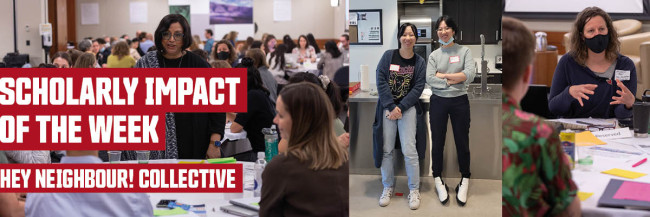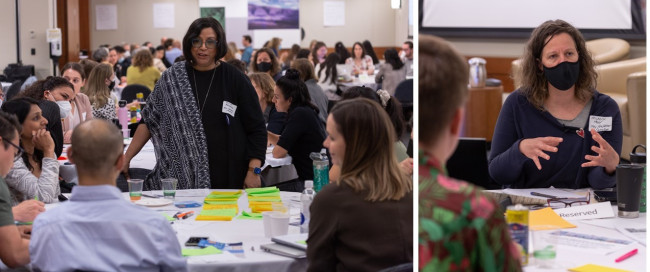
Social connectedness has been shown to strengthen individual and community health, well-being and resilience. However, a recent Angus Reid poll found that close to half of Canadians report having few regular interactions outside their family units or with their neighbours—many members of Canadian society are at risk of social isolation.
The Hey Neighbour Collective (HNC) is a project of Simon Fraser University’s (SFU) Morris J. Wosk Centre for Dialogue, directed by Michelle Hoar. HNC strives to build connectedness and resiliency in British Columbia communities and counter the trend towards an asocial society. It brings together housing providers, non-profits, researchers, governments, housing associations and health authorities to experiment with and learn about ways to create social connectedness in B.C.’s fast-growing multi-unit housing communities.
SFU researchers from several disciplines contribute to HNC. Professors Meg Holden (Urban Studies and Resource and Environmental Management); Atiya Mahmood, (Gerontology) and Meghan Winters (Health Sciences) are research co-leads working with practice partners, advisors and learning network partners to create and support a community of practice. SFU research assistants from Urban Studies, Gerontology, Health Sciences and Public Policy have been instrumental in HNC. Members have developed discussion papers, toolkits, practice guides and publish research to help foster neighbour-to-neighbour connectedness in multi-unit housing.

SFU gerontology professor Atiya Mahmood (left) and Hey Neighbour Collective Director Michelle Hoar (right) at the Living Together symposium at SFU’s Morris J. Wosk Centre for Dialogue in Vancouver, June 2022.
Holden, Mahmood and Winters recently published Social Quality of Life in High-Density Built Environments, examining quality of life in these households and communities, in the context of the Emerging Asocial Society. The report was co-authoured with SFU postdoctoral fellow MohammadJavad Nouri and PhD student Meridith Sones.
Their work demonstrates that promoting and planning for neighbourly social connections in high-density environments can make a positive contribution towards achieving housing, health and social policy goals that offset the trend toward social isolation.
SFU researchers [l-r] Mohammadjavad Nouri, Meg Holden, Meridith Sones, Meghan Winters, Atiya Mahmood authored the report, Social Quality of Life in High-Density Built Environments.
We spoke with Meg Holden and Michelle Hoar about the work of HNC.
How did the project come about? Was it in response to the isolation during the COVID-19 pandemic or the growing trend towards an asocial society?
The impetus for HNC arose pre-pandemic from concern about the impact of loneliness and social isolation on the prospects for our region’s sustainability and well-being into the future. The Vancouver Foundation published a flagship survey on this in 2012, and I [Holden] was an advisor on this report. As an urbanist, this trend sounded an alarm bell that our densifying built environment could be a scapegoat for this rise in asociability, out of anti-urban bias rather than evidence.
Winters came to the collective from a concern for the effects of loneliness and social isolation on public health, and Mahmood from a specific concern about the importance of social connections for health and quality of life for older adults. We united around the potential to better understand and address sociability and critical social connections in housing and home environments, because housing affordability and quality is such an all-encompassing concern.
The short answer is no, HNC did not come about in response to COVID-19—but we were glad to have put some roots down when the pandemic hit and brought this issue so front and centre.
We have heard about mental health, technologies like social media and artificial intelligence, and less time for volunteering and other kinds of participation, as contributing to loneliness and social isolation trends. What is HNC’s particular take on why society is trending towards becoming more asocial?
The Social Sciences and Humanities Research Council (SSHRC) Imagining Canada’s Future initiative pointed to 16 critical challenges that Canada needs new evidence and strategies to address in the coming decades. When HNC saw that one of the challenge areas was the Emerging Asocial Society, we wanted to contribute to that knowledge synthesis so that factors associated with housing were considered, and for housing professionals and related urban and community planning researchers and practitioners to be part of the solution.
Another way to put it is that HNC looks at multi-unit housing communities as places full of opportunity to address loneliness and social isolation, and to build up neighbourly social connections as a form of community resilience. Our homes can connect us or isolate us, so we want to promote any and all promising practices for connection.
Are cities worldwide contending with isolation or is this just a North American concern?
Both Canada’s Chief Public Health Officer and recently the Surgeon General in the United States have signaled the need for concerted policy attention to social connections in our communities—but, this issue is recognized in other countries too. Among cities, Barcelona stands out for its Municipal Strategy to Combat Loneliness. New Zealand stands out for efforts to formally redefine ‘housing quality’ not just in terms of size, structure and cost—as we do in Canada—but also in terms of its functional, social and cultural value for households, families and extended social groups. In B.C., from 2016 to 2021, the rate of high-rise housing growth was five times faster than single detached homes. Yet our social, health and community policy and planning approaches are based on outdated, suburban expectations of community form and function. We need to rethink how communities connect, across all kinds of households, as we grow.
What are some of the strategies or activities that HNC members and partners have found effectively counter loneliness and isolation at home?
Our report contains evidence about improving social quality of life by attention to six factors: individual and household characteristics; housing status and structure; personality, agency and attitude; governance models; social comparisons and distinctions; and design. Some of these are things we can understand and act on within our own households and neighbourhoods, others are considerations for designers, housing providers, governments and advocates.
Our understanding of the issues and what is at stake in pro-social living has been aided immensely by the richness of our partnerships and our community of practice. This is a group of housing and service providers, advocates, municipalities, public health professionals and others who bring their concerns, experiments and new directions to HNC. By putting our heads together, we have published a host of resources about the vital roles that different groups can play in fostering neighbour-to-neighbour connectedness and social resilience in multi-unit housing.
Can organizations or citizens reach out to HNC if they need advice or want to become involved?
We do host webinars and workshops—we will be hosting one at the Planning Institute of B.C.
It Takes a Village conference at the end of May. We send out a quarterly eNewsletter full of new information and ideas, and have an active presence on Twitter and LinkedIn. These are all great ways to stay abreast of what we are learning and sharing.
HNC also hosts a ton of different resources, including practice guides for different groups interested in making social connections at home.
As HNC evolves, we aim to engage directly with a wider group of housing operators and non-profits interested in doing their part within housing to combat loneliness and social isolation. We hope that people will connect with us and become part of our vision of a future where Canada’s multi-unit housing communities are socially connected, neighbourly, health-promoting and resilient.
Learn more by visiting www.heyneighbourcollective.ca.
SFU's Scholarly Impact of the Week series does not reflect the opinions or viewpoints of the university, but those of the scholars. The timing of articles in the series is chosen weeks or months in advance, based on a published set of criteria. Any correspondence with university or world events at the time of publication is purely coincidental.
For more information, please see SFU's Code of Faculty Ethics and Responsibilities and the statement on academic freedom.